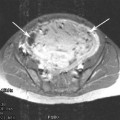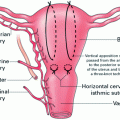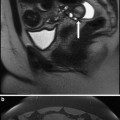John Reidy, Nigel Hacking and Bruce McLucas (eds.)Medical RadiologyRadiological Interventions in Obstetrics and Gynaecology201410.1007/174_2013_851
© Springer-Verlag Berlin Heidelberg 2013
UAE is not Recommended for Women Wishing to Conceive
(1)
Department of Obstetrics and Gynecology, McGill University, Montreal, Quebec, Canada
Abstract
Although considered a fertility saving option in women of reproductive age, current evidence suggests that uterine artery embolization can have an adverse effect on ovarian function as well as on future pregnancies. Uterine artery embolization is associated with a risk of premature ovarian failure, as well as occasional injury to the endometrium resulting in endometrial atrophy and adhesion formation. All of these including a subtle reduction in the ovarian reserve jeopardise fertility. Pregnancies following uterine artery embolization can be complicated by an increased rate of miscarriage, preterm delivery, intra-uterine growth restriction, malpresentation, abnormal placentation and post-partum hemorrhage. In view of the possibility of impaired ovarian function as well as increased pregnancy complications, women with fibroids who wish to conceive should not be treated with uterine artery embolization. Myomectomy should be recommended as the treatment of choice over uterine artery embolization in women desiring future fertility. The effect of uterine artery embolization for post-partum hemorrhage on future fertility is currently uncertain.
1 Introduction
Uterine artery embolization is a vascular radiological procedure, which in recent years has gained recognition as a treatment option in the management of uterine myomas and post-partum hemorrhage. Although it aims to keep the uterus intact and is often regarded as a fertility conserving option in women of reproductive age, evidence suggests that uterine artery embolization can have an adverse impact on fertility.
2 Uterine Artery Embolization for Uterine Myomas
Uterine fibroids can cause menorrhagia, pelvic pain and symptoms of pelvic pressure. Several studies have shown that submucous and cavity-distorting intra-mural fibroids can impair implantation and placental development, leading to infertility and miscarriage (Bernard et al. 2000; Farhi et al. 1995; Pritts et al. 2009). In women with submucous myomas, hysteroscopic myomectomy resulted in a significant increase in the conception rate as compared to those in whom the myoma was not removed (Casini et al. 2006; Shokeir 2005; Somigliana et al. 2007). Casini et al. (2006) in their prospective randomized study involving 181 women affected by uterine fibroids, observed that in the group of women with submucosal fibroids, when surgery was not performed the pregnancy rate was 27.2 % with a miscarriage rate of 50.0 %, whereas the corresponding rates were 43.3 % and 38.5 % in women who underwent surgery (p < 0.05).
Uterine artery embolization (UAE) has been gaining in popularity in recent years as an alternative to hysterectomy in women with uterine fibroids. It is performed under local anaesthesia with intravenous conscious sedation. It has the advantage of being an out-patient procedure or overnight stay is required at most. The procedure is performed by passing a catheter through the femoral artery and advanced up to the distal part of the uterine artery followed by injection of the embolizing agent under angiographic guidance. It is then repeated on the opposite side.
Various embolic agents have been used, including tris-acryl microspheres, gelfoam and polyvinyl alcohol (PVA). It has been shown that larger trisacryl gelatin microspheres (700–900 micron) penetrate significantly deeper into myoma tissue compared with non-spherical PVA particles (355–500 micron) (Chua et al. 2005). Due to the irregular shape and size of the PVA particles and their tendency to aggregate, occlusion tends to be more proximal than required. Large microspheres may therefore have the advantage of specifically targeting the myoma tissue and minimising ischaemic injury to normal myometrium and reduce the possibility of entering the utero-ovarian collaterals (Chua et al. 2005). However, larger studies are required to substantiate these findings.
In a randomized study comparing the outcomes of UAE using tris-acryl gelatin microspheres versus PVA, those treated with tris-acryl gelatin microspheres were more likely to have complete infarction of all myomas and at least 90 % tumour infarction compared with patients treated with PVA. In this study, the authors used particles with 500–700 micron sizes followed by 700–900 microns (Spies et al. 2005a). Following occlusion, uterine ischaemia occurs and the myometrium becomes hypoxic. The myometrium is re-perfused by collateral arteries, and blood clots are lysed. The myoma undergoes infarction and ischaemic necrosis (Burbank and Hutchins 2000). Adverse events of UAE include infection, transcervical expulsion of a fibroid, non-purulent vaginal discharge, pelvic pain, delayed diagnosis of leiomyosarcoma, diminished ovarian reserve and premature ovarian failure.
In observational studies, UAE was followed by a decrease in excessive uterine bleeding in 90 % of women, 35–60 % reduction in uterine volume and a low rate of subsequent hysterectomy. In a randomized study of women with intramural myoma larger than 4 cm, UAE was reported to be as effective as myomectomy, but myomectomy was associated with more pregnancies and deliveries and fewer miscarriages (Mara et al. 2008). Yet, symptoms may persist in 20 % of women after UAE, necessitating other procedures, such as repeat embolization, hysterectomy or myomectomy (Spies et al. 2005b).
2.1 Fertility After Uterine Artery Embolization for Uterine Myomas
Several studies have highlighted the possibility of diminished ovarian function following UAE. In a randomized trial comparing UAE and hysterectomy, UAE was associated with decreased ovarian reserve, as demonstrated by a significant increase in FSH and fall in antimullerian hormone (Hehenkamp et al. 2007). Ovarian failure has been reported in up to 8 % of women following uterine artery embolization (Spies et al. 2005c). Decreased ovarian function after UAE is presumably due to embolization of the utero-ovarian collaterals decreasing the blood supply to the ovaries (Tulandi et al. 2002). The loss in ovarian function is age related and could be permanent or transient. Although the changes in menstrual function are usually transient, a particular concern is the possibility of decreased ovarian reserve reducing the chance to conceive. The incidence of premature menopause after UAE is 1–2 % in women younger than 45 years and 15–20 % in perimenopausal women over the age of 45 (Tulandi and Salamah 2010). On the contrary, myomectomy preserves ovarian function, making it the preferable intervention in women who wish to conceive.
Atrophic endometrium after fibroid embolization in woman with normal ovarian function has also been reported. Tropeano et al. (2003) reported a case of endometrial atrophy after uterine artery embolization with 150–250 μm polyvinyl alcohol microparticles for symptomatic fibroids. Post-treatment measurements of serum FSH, estradiol and ovarian imaging showed no change in ovarian function as compared with the baseline (Tropeano et al. 2003). Women should therefore be advised that uterine artery embolization may have a potential adverse effect on future fertility.
2.2 Pregnancy After Uterine Artery Embolization for Uterine Myomas
The safety of pregnancy after uterine artery embolization remains uncertain. Results from several studies suggest that pregnancies after UAE are complicated by an increased rate of miscarriage, preterm delivery, abnormal placentation, malpresentation and post-partum hemorrhage as compared to myomectomy (Goldberg et al. 2004; Pron et al. 2005; Tulandi 2007; Tulandi and Salamah 2010; Walker and McDowell 2006).
In a randomized trial comparing UAE versus myomectomy, there were significantly more pregnancies and fewer miscarriages following myomectomy than after UAE (Mara et al. 2008). In this study, in which 58 women were randomized to UAE and 63 to myomectomy, there were 33 pregnancies in 40 women after myomectomy as compared to 17 pregnancies among 26 women during the first 2 years of follow-up. The abortion rate was 64 % after UAE and 23 % after myomectomy (Mara et al. 2008).
Other studies have also demonstrated a high rate of miscarriage after UAE. In the Ontario multicenter prospective trial (Pron et al. 2005), the post-UAE spontaneous miscarriage rate was 16.7 % (24 pregnancies in 21 women of mean age 34 years), whereas the miscarriage rate was 27 % in the retrospective trial of Carpenter and Walker (26 pregnancies; mean age of patients, 37 years) (Carpenter and Walker 2005). Similarly, in a study comparing the pregnancy outcome after UAE versus laparoscopic myomectomy, there was an increased risk of miscarriage after UAE (24 %) as opposed to 15 % after laparoscopic myomectomy (Goldberg et al. 2004). In a retrospective analysis of 1,200 women who underwent UAE, 56 women conceived, but only 33 pregnancies had successful outcomes. There were 17 miscarriages, 2 stillbirths, 3 terminations and 1 ectopic pregnancy. There were 6 premature deliveries and 6 pregnancies were complicated by post-partum hemorrhage (Walker and McDowell 2006).
The increased rate of miscarriage after UAE was also illustrated in a prospective multi-centre study comparing laparoscopic uterine artery occlusion with UAE in women with symptomatic fibroids (Holub et al. 2008). Furthermore, hysteroscopic examination of the uterine cavity revealed that patients previously treated for intramural myomas by UAE had a significantly higher incidence of abnormal findings in the uterine cavity as compared to those after laparoscopic uterine artery occlusion (Kuzel et al. 2011). These included a necrotic defect of the endometrium, specifically, a fistula between the uterine cavity and intramural necrotic myoma.
In a recent metaanalysis involving 227 completed pregnancies after UAE, Homer and Saridogan (2010) found that miscarriage rates were higher in UAE pregnancies (35.2 %) compared to fibroid-containing pregnancies matched for age and fibroid location (16.5 %) (odds ratio [OR] 2.8; 95 % confidence interval [CI] 2.0–3.8). They also found that UAE pregnancies were more likely to be delivered by caesarean section (66 % vs. 48.5 %; OR 2.1; 95 % CI 1.4–2.9) and to experience post-partum hemorrhage (13.9 % vs. 2.5 %; OR 6.4; 95 % CI 3.5–11.7) (Homer and Saridogan 2010).
Pregnancies after UAE were also associated with higher rates of preterm delivery and malpresentation than pregnancies following laparoscopic myomectomy. In a study comparing data from 53 pregnancies after UAE and 139 pregnancies after laparoscopic myomectomy, a higher risk of preterm delivery and malpresentation was reported in the UAE group (Goldberg et al. 2004). An increased incidence of intra-abdominal adhesions probably due to coagulation necrosis of the leiomyoma following UAE has also been reported (Agdi et al. 2008).
Several studies have highlighted the increased frequency of post-partum hemorrhage following UAE (Goldberg et al. 2004; Pron et al. 2005). A multi-centre study involving 555 women with symptomatic leiomyoma, reported an increased incidence of abnormal placentation following UAE, which included placenta previa and placenta accreta resulting in caesarean hysterectomy. There was also an increased incidence of post-partum hemorrhage secondary to placental abnormalities (Pron et al. 2005). The primary embolic agent used in this study was 355–500 micron polyvinyl alcohol particles. Likewise, a retrospective analysis of 56 completed pregnancies after UAE showed that compared with the general obstetric population, there was a significant increase in post-partum hemorrhage in pregnancies after UAE (Walker and McDowell 2006).
In view of the above, women presenting with fibroids who wish to conceive are therefore not generally eligible for embolization (ACOG Committee Opinion 2004). Women with submucous fibroids should be treated by hysteroscopic myomectomy and they are not candidates for embolization (Lefebvre et al. 2003; Tulandi and Salamah 2010). Hence, although pregnancies following uterine artery embolization have been reported, myomectomy should be recommended as the treatment of choice over uterine artery embolization in women desiring future fertility.







